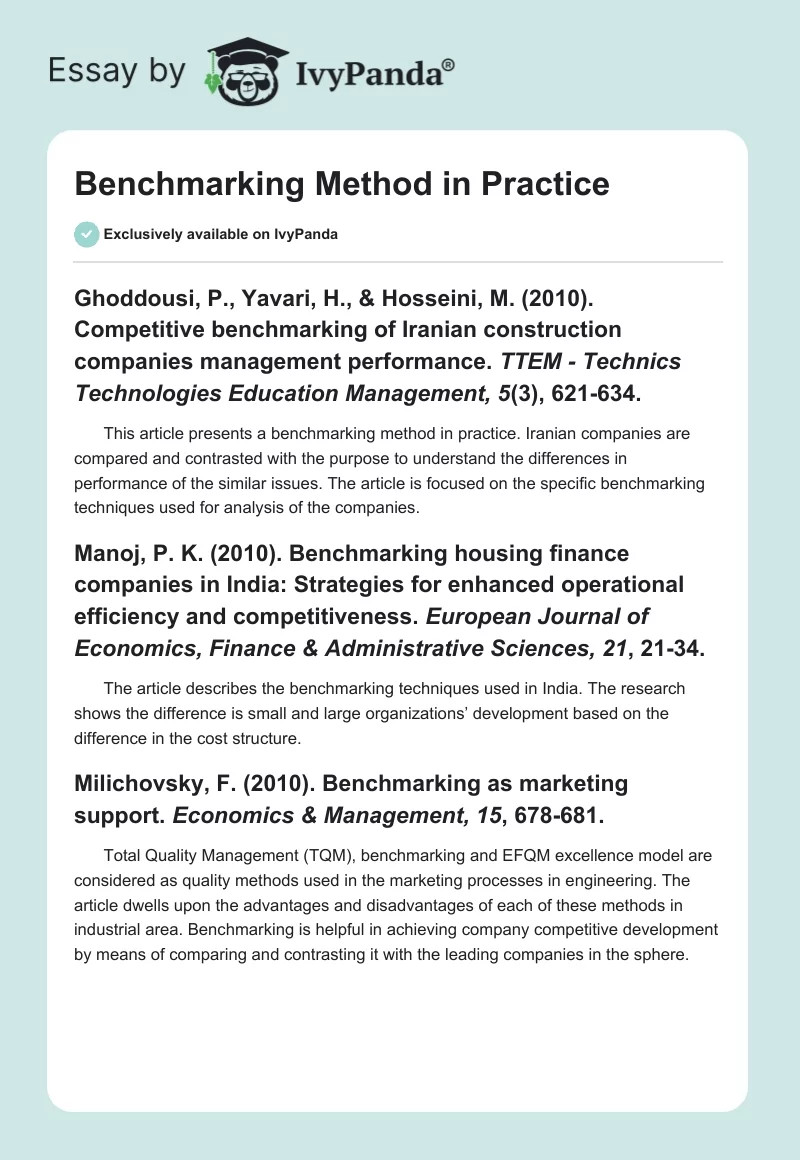Ghoddousi, P., Yavari, H., & Hosseini, M. (2010). Competitive benchmarking of Iranian construction companies management performance. TTEM – Technics Technologies Education Management, 5(3), 621-634.
This article presents a benchmarking method in practice. Iranian companies are compared and contrasted with the purpose to understand the differences in performance of the similar issues. The article is focused on the specific benchmarking techniques used for analysis of the companies.
Manoj, P. K. (2010). Benchmarking housing finance companies in India: Strategies for enhanced operational efficiency and competitiveness. European Journal of Economics, Finance & Administrative Sciences, 21, 21-34.
The article describes the benchmarking techniques used in India. The research shows the difference is small and large organizations’ development based on the difference in the cost structure.
Milichovsky, F. (2010). Benchmarking as marketing support. Economics & Management, 15, 678-681.
Total Quality Management (TQM), benchmarking and EFQM excellence model are considered as quality methods used in the marketing processes in engineering. The article dwells upon the advantages and disadvantages of each of these methods in industrial area. Benchmarking is helpful in achieving company competitive development by means of comparing and contrasting it with the leading companies in the sphere.
Nikolić, M., Sajfert, Z., & Vukonjanski, J. (2009). Benchmarking of PR function in Serbian companies. South East European Journal of Economics & Business, 4(2), 103-119.
Benchmarking of the PR function in Serbian companies is the focus of discussion in this article. The article presents the possible methodologies for benchmarking PR managers in the existing companies. One of the main conclusions of the research is the consideration that such benchmarking techniques may be used for other business processes.
Shah, D., & Kleiner, B. H. (2011). Benchmarking for quality. Industrial Management, 53(2), 22.
The article under consideration is focused on benchmarking as the way for quality control and improvement. Quality measuring is the main idea for discussion.
The process of benchmarking and the steps for quality improvement on the basis of the chosen technique are discussed in the article. One should remember that continuous improvement, new product development, and identifying new markets are the areas of benchmarking influence.
Tervonen, P., Alapiha, J., & Haapasalo, H. (2011). Benchmarking ESSQ management systems. Journal of Modern Accounting & Auditing, 7(1), 59-66.
The main purpose of this article is to use the ESSQ framework for analysis the Finnish international companies. The article helps draw the conclusions that the companies which have similar system, such as environmental, safety and quality, they usually have various performance levels as they stress various issues. Thus, benchmarking is considered as the way for credible way for analyzing companies.


